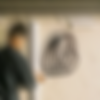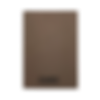
SCRIBBLERS - Doodling with Nargue (Curated by GROG)
Interview: Pietro Rivasi
Text: Judy Rhum
Direction: Simone Natale
We have seen so many tags over the years, until our obsessive eyes gazed across a different one. We launch the Scribblers series by paying tribute to Europe's ongoing contribution to the movement by stepping in with a French writer representative of one of those nations that for years has continued to export innovations and formal and attitude cues while providing new enrichment to the scene. Through an analysis and an interview from Grog Lifestyle Vol.2, we welcome Nargue from Paris.

NARGUE. Born in 1993, his tag has got a complex structure, to the point that an inexperienced eye struggles to recognise real letters in it, it is a matter of concentration and analysis of the structure to identify them, then everything will make sense.
Doodling is a repetition of almost childish graphic signs, reminiscent of children's first approach to drawing. Grab a marker and let the imagination drag your hand, transforming the gibberish scribbles into proper concepts. Keith Haring can be considered an expert of this practice, which has seen various copycats follow one another over the years, gaining fame on Social Media. The Internet spits cheesy versions of past styles, easy to digest for an audience that is fascinated by appearance and unconcerned with the content. Even in the world of graffiti there have been many attempts, such as the incomprehensible one-line tags phenomenon. It is impossible to get a cool tag if the connections between letters do not follow a style, it is a bit like spending the night drinking tequila and having a beer before going to bed: you can imagine what would happen!
Not all writers give hand-style the same importance, some have never even attempted a flop in their career and the tags next to shiny pieces are often ugly. That is perhaps because apparently the sacred texts have transmitted to the faithful the sacredness of the masterpiece more than the throw up cult or, even more, the tag’s. Actually that’s false: just think of Lee, Cap, Comet, Quick, Ghost, Iz and many other pioneers who mastered throw ups and tags. So what’s the matter?
Probably the old saying “less is more” helps us to understand: the less elements, the more difficult is to do interesting and innovative stuff, in graffiti too. But we, fanatics of stains, halos, drips and forms full of flow know there’s still writers who master the basics.


Nargue is definitely one: he started sketching at primary schools when with his friends copied video games’ logos or the scribblings they saw mingling around the block. Then at the beginning of middle school, he started focusing on tags, the most evident form of expression around him and at that point hand style became the focus of all his research: far from being devoted to classic calligraphy, Nargue considers tagging a discipline that needs dedication and reflection to be able to pull out standing out productions in an environment full of visual noise, with no fear to break the “rules of graffiti”.
It all started by printing black and white images of trucks, phone cabins, store fronts and reproducing the tags he saw around on those prints, adding his own to the crowd, trying to reach the same energy, the same flow as the originals, a fun way to understand how the writers reached balance and nice handstyles. Then came in field practice.
N: “I started writing being really influenced by my city and my country’s scene but also quickly started to learn about what was going on in other parts of the world like NYC, Philly and later on Pixos from Brazil: all those hand styles caught my eye and changed my perception. Sizes, different codes and ways of tagging were really intriguing and above all, it was stuff that I wasn’t able to read but in which I could feel the energy, balance and flow. That really helped me developing my own way.”


Probably the pivotal quality of his research is considering his tag a whole and not a sequence of signs that random people should be able to interpret as a word, even if lots of people criticize this choice and react like what the fuck is that? — bystanders in fact need knowledge, patience and good deciphering to read his monogram.
But for Nargue it’s all about the the graphic impact and this kind of complaints don’t bother him at all. The fact that he’s into this type of tags, circle-based and almost abstract, doesn't mean he does not respect or don’t enjoy capital-letters-based, readable tags he learned from: in Paris, there's rooted tradition of simple and impactful styles full of personality and he still enjoy seeing them.
N: “Personally I’d rather spend a night putting up 20 complicated tags that take 25 seconds each, then doing hundreds of readable that I also do when I find a good and visible spot but too small for a complex one. I prefer tags to pieces generally speaking, I'm not a patient guy and doing a big piece with all the classic elements requires more material and preparation. I feel more free with hand styles: it comes from the heart, you just let it go and it's finished.”


Most of his research on letters, connections, forms and flows happens on paper, so that when in the streets he can act instinct-driven, considering the surface, the tool and how they combine. This way, letters and forms come spontaneously from what has been sketched before on paper.
In the streets, sometimes adrenaline plays jokes and some letters do not turn out how they were supposed to, but even a bad tag may contain good elements to be-used consciously later on.
Clenched tags are his main passion, Nargue thinks they’re not enough and wanted to create a wider creative universe first off all using two colors in some,then adding background, solid shapes and forms, creating paintings that are an extension of the signing practice.
N: “Even if I still do classic graffiti from time to time, I feel more touched by abstract paintings than pure letters at the moment and I found my way to combine my tagging activity with them: no figures, something apparently simple but difficult to do at the same time.”


The situation in Paris is no longer how it used to be, all the shutters are getting buffed and the situation feels more static and not very challenging for him. While absolutely not into calligraphy and even less calligraffiti, Nargue is an enthusiast of the wider world of Contemporary Art, something he follows with genuine curiosity and that in some cases, he rates even more than graff itself!
N: “I feel like even if a lot of people are doing different things, graffiti is still very, very conservative, something you don't see in the contemporary art world, where literally anything can be considered art. In graffiti, when you exit a bit from the classical frame of forms, you get lots of criticism: people wants the same shit over and over, or it's not considered graffiti. It’s a very conservative movement and sometimes the narrow minded-ness of people, pisses me off.”
You can buy Grog Lifestyle Zine Vol.2 A5 LTD on spectrumstore.com
Do you own a store? Do you want to sell the Grog products? Request your account activation on our B2B portal.




